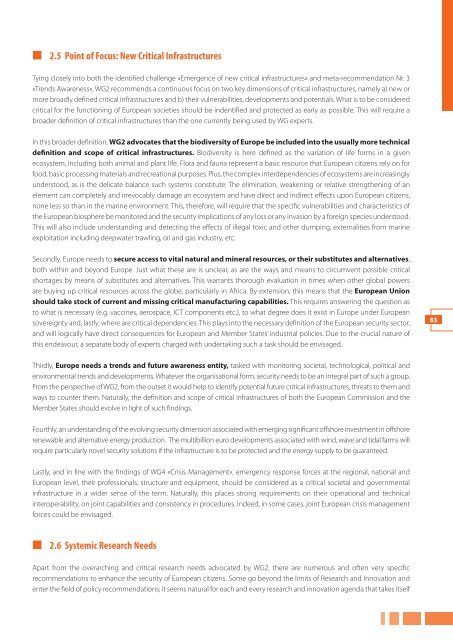I527-290 ESRIF Final Report (WEB).indd - European Commission
I527-290 ESRIF Final Report (WEB).indd - European Commission
I527-290 ESRIF Final Report (WEB).indd - European Commission
Create successful ePaper yourself
Turn your PDF publications into a flip-book with our unique Google optimized e-Paper software.
2.5 Point of Focus: New Critical Infrastructures<br />
Tying closely into both the identifi ed challenge «Emergence of new critical infrastructures» and meta-recommendation Nr. 3<br />
«Trends Awareness», WG2 recommends a continuous focus on two key dimensions of critical infrastructures, namely a) new or<br />
more broadly defi ned critical infrastructures and b) their vulnerabilities, developments and potentials. What is to be considered<br />
critical for the functioning of <strong>European</strong> societies should be indentifi ed and protected as early as possible. This will require a<br />
broader defi nition of critical infrastructures than the one currently being used by WG experts.<br />
In this broader defi nition, WG2 advocates that the biodiversity of Europe be included into the usually more technical<br />
defi nition and scope of critical infrastructures. Biodiversity is here defi ned as the variation of life forms in a given<br />
ecosystem, including both animal and plant life. Flora and fauna represent a basic resource that <strong>European</strong> citizens rely on for<br />
food, basic processing materials and recreational purposes. Plus, the complex interdependencies of ecosystems are increasingly<br />
understood, as is the delicate balance such systems constitute: The elimination, weakening or relative strengthening of an<br />
element can completely and irrevocably damage an ecosystem and have direct and indirect eff ects upon <strong>European</strong> citizens,<br />
none less so than in the marine environment. This, therefore, will require that the specifi c vulnerabilities and characteristics of<br />
the <strong>European</strong> biosphere be monitored and the security implications of any loss or any invasion by a foreign species understood.<br />
This will also include understanding and detecting the eff ects of illegal toxic and other dumping, externalities from marine<br />
exploitation including deepwater trawling, oil and gas industry, etc.<br />
Secondly, Europe needs to secure access to vital natural and mineral resources, or their substitutes and alternatives,<br />
both within and beyond Europe. Just what these are is unclear, as are the ways and means to circumvent possible critical<br />
shortages by means of substitutes and alternatives. This warrants thorough evaluation in times when other global powers<br />
are buying up critical resources across the globe, particularly in Africa. By extension, this means that the <strong>European</strong> Union<br />
should take stock of current and missing critical manufacturing capabilities. This requires answering the question as<br />
to what is necessary (e.g. vaccines, aerospace, ICT components etc.), to what degree does it exist in Europe under <strong>European</strong><br />
sovereignty and, lastly, where are critical dependencies. This plays into the necessary defi nition of the <strong>European</strong> security sector,<br />
and will logically have direct consequences for <strong>European</strong> and Member States’ industrial policies. Due to the crucial nature of<br />
this endeavour, a separate body of experts charged with undertaking such a task should be envisaged.<br />
Thirdly, Europe needs a trends and future awareness entity, tasked with monitoring societal, technological, political and<br />
environmental trends and developments. Whatever the organisational form, security needs to be an integral part of such a group.<br />
From the perspective of WG2, from the outset it would help to identify potential future critical infrastructures, threats to them and<br />
ways to counter them. Naturally, the defi nition and scope of critical infrastructures of both the <strong>European</strong> <strong>Commission</strong> and the<br />
Member States should evolve in light of such fi ndings.<br />
Fourthly, an understanding of the evolving security dimension associated with emerging signifi cant off shore investment in off shore<br />
renewable and alternative energy production. The multibillion euro developments associated with wind, wave and tidal farms will<br />
require particularly novel security solutions if the infrastructure is to be protected and the energy supply to be guaranteed.<br />
Lastly, and in line with the fi ndings of WG4 «Crisis Management», emergency response forces at the regional, national and<br />
<strong>European</strong> level, their professionals, structure and equipment, should be considered as a critical societal and governmental<br />
infrastructure in a wider sense of the term. Naturally, this places strong requirements on their operational and technical<br />
interoperability, on joint capabilities and consistency in procedures. Indeed, in some cases, joint <strong>European</strong> crisis management<br />
forces could be envisaged.<br />
2.6 Systemic Research Needs<br />
Apart from the overarching and critical research needs advocated by WG2, there are numerous and often very specifi c<br />
recommendations to enhance the security of <strong>European</strong> citizens. Some go beyond the limits of Research and Innovation and<br />
enter the fi eld of policy recommendations; it seems natural for each and every research and innovation agenda that takes itself<br />
83

















